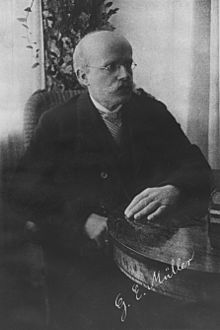Georg Elias Müller facts for kids
Quick facts for kids
Georg Elias Müller
|
|
|---|---|

Georg Elias Müller
|
|
| Born | 20 July 1850 |
| Died | 23 December 1934 (aged 84) Göttingen, Germany
|
| Nationality | German |
| Alma mater | Leipzig University University of Göttingen (Dr.phil., 1873) |
| Scientific career | |
| Fields | Experimental psychology |
| Institutions | University of Göttingen |
| Thesis | Zur Theorie der sinnlichen Aufmerksamkeit (On the Theory of Sensory Attention) (1873) |
| Doctoral advisor | Hermann Lotze |
Georg Elias Müller (born July 20, 1850 – died December 23, 1934) was an important German psychologist. He is known for his ideas about how we forget things. He also helped create the field of experimental psychology.
Contents
Biography
Early life and education
Georg Elias Müller was born in Grimma, Germany, on July 20, 1850. His father was a religion professor. Georg went to school in Leipzig when he was a child.
At 18, he started studying history and philosophy at Leipzig University. He was a very dedicated student. Müller took two years off from his studies to join the German army. He fought in the Franco-Prussian War in 1870. After the war, he decided to focus on philosophy, which led him to study psychology.
Becoming a psychologist
Müller was inspired by his teachers, especially Hermann Lotze and Gustav Theodor Fechner. Fechner taught him about psychophysics, which studies how our minds react to physical things. Lotze encouraged Müller to think critically and do scientific research.
In 1873, Müller earned his doctorate degree from the University of Göttingen. His main focus was on how we pay attention. In 1881, he took over Lotze's position at Göttingen. There, he started one of the world's first laboratories for experimental psychology.
Müller spent 40 years at Göttingen. He was an experimental psychologist, meaning he did many careful experiments. He studied how fast people react to things, how we see colors, and how our minds work with physical sensations. He also invented a special device called a "memory drum" to help with memory research.
Key contributions
Müller helped develop the "interference theory" of forgetting. This theory explains why we sometimes forget things because new information gets in the way. He also led the German Society of Experimental Psychology for many years.
Works in psychology
Color vision
After Müller retired in 1922, he continued to study how we see colors. He built on the ideas of another scientist, Ewald Hering. Müller suggested a "two-stage theory" of color vision. First, our eyes' receptors pick up light. Then, these signals are changed into four main colors: red, green, blue, and yellow.
Memory research
Müller's most famous work was in the field of memory. He studied how different kinds of images affect our ability to remember. He believed that thinking about unclear images could help us learn better.
He worked with Gottfried Rückle, a math student with an amazing memory. Together, they studied how grouping information helps us learn and remember.
Memory consolidation
Müller and his student Alfons Pilzecker came up with the idea of "consolidation." This means that when we learn something new, it takes time for that memory to become permanent. It's like the memory needs to "settle in" to our brains.
To test this, they used "nonsense syllables" (like "DAX" or "ZUG") that Hermann Ebbinghaus had used. They measured how many tries it took for people to learn these syllables perfectly. They found that if people were distracted right after learning, they remembered less.
Sometimes, participants in their experiments would keep thinking about the syllables even when they tried not to. Müller and Pilzecker called this "perseveration."
Retroactive interference
Müller and Pilzecker also developed the theory of "retroactive interference." This happens when learning new things makes it harder to remember old things.
Here's how they tested it:
- Participants learned a list of syllables for six minutes.
- Then, some participants were shown landscape paintings and asked to describe them. This was the "distraction."
- Other participants had no distraction.
- Finally, everyone was tested on how much they remembered from the syllable list.
They found that the group who described the paintings remembered less of the syllables. This showed that the new information (the paintings) interfered with remembering the old information (the syllables).
Works
- Zur Theorie der sinnlichen Aufmerksamkeit ("On the theory of sensory awareness," 1873)
- Zur Grundlegung der Psychophysik ("On foundations for psychophysics," 1878)
- Zur Theorie der Muskelcontraction ("On the theory of muscle contractions," 1891)
- Experimentelle Beiträge zur Lehre vom Gedächtnis, with Pilzecker ("Experimental contributions to the science of memory," 1900)
See also
 In Spanish: Georg Elias Müller para niños
In Spanish: Georg Elias Müller para niños

